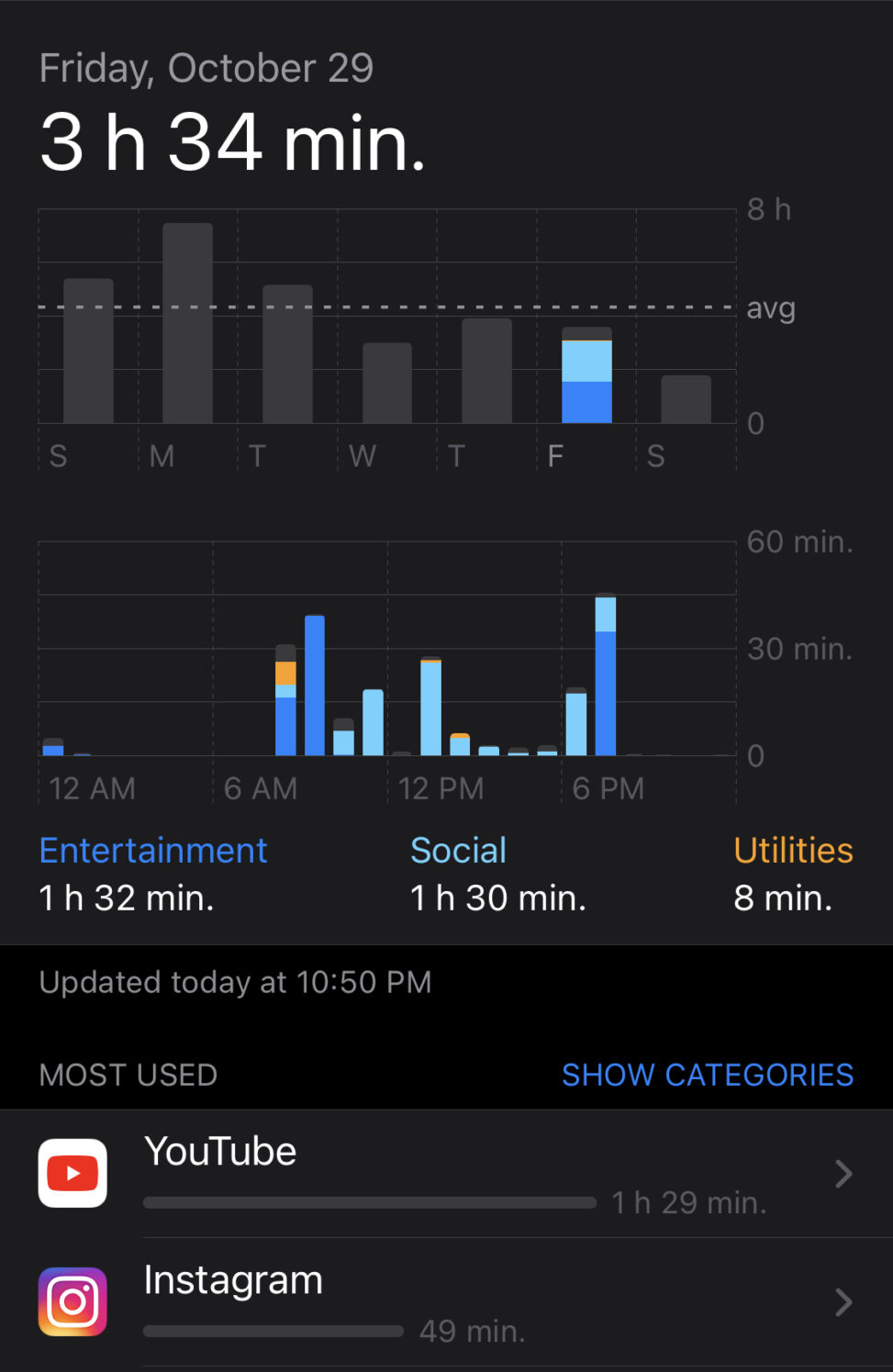| Social Media: | Youtube | Total of all apps | ||
| Day 1: Oct 29 | Actively watched: 19 videos
Actively watched for: 2 hours and 42 minutes |
49 minutes | N/A | 3 hours and 30 minutes |
| Day 2: Oct 30 | Actively watched: 8 videos
Actively watched for: 2 hours and 18 minutes |
1 hour and 8 minutes | N/A | 3 hours and 26 minutes |
| Day 3: Oct 31 | Actively watched: 123 videos
Actively watched for: 3 hours 30 minutes Passively watched: 2 videos Passively watched for: 1 hour and 1 min |
Actively scrolling: 47 minutes
2 images sent to me 1 image sent by me |
Actively scrolling: 43 minutes | 5 hours |
| Total per app | 8 hours and 30 mins actively
1 hour and 1 min passively 9 hours and 31 minutes total |
2 hours and 42 minutes | 43 minutes | 11 hours and 56 minutes across all apps for three days
12 hours and 57 minutes counting passive viewing |
Essay
Media is designed to draw us in and keep us chained to our screens for as long as possible. Trying to pull away from the screen is a problem even for neurotypical people, but when it comes to those with mental illnesses such as ADHD or other issues with impulsivity and or dopamine issues that chain can very easily become inescapable. As both a digital native and a person with ADHD, I have experienced the ways in which social media allows us to connect more with others, but also keeps us trapped and isolates us from the outside world. I will be primarily examining the media I have consumed over the course of three days across three social media platforms. Youtube, Instagram, and Reddit.
The barrages of alerts combined with the drip-feed of dopamine through instant gratification without actually giving us enough to feel satisfied enough to pull away from our screens make social media incredibly addictive. On top of that, those with ADHD are already at an elevated risk of substance abuse and we are living our lives in an environment that was designed to be addictive. Since there are many different definitions of addiction, I will be using the definition provided by Ethics of the Attention Economy: The Problem of Social Media Addiction they claim that all addictions have six common components. However, I will be focusing on the two indicators most relevant to my media consumption experiences, conflict and relapse. Conflict is when “the addict has conflicts within oneself or with those around them or experiences other adverse circumstances or damage” (para. 6). Sadly, I can attest to the conflict, in doing this assignment I discovered that over the course of three days I have spent nearly 12 hours actively watching media and yet, and even after realizing how much time I lose for what little I gain from media, I am still consuming ever-increasing amounts of media. And lastly, relapse. The amount of times I have decided to quit social media only to come back to it the next day is innumerable.
After reading all of this, the solution of deciding to limit the times we are able to use these media platforms seems like an easy solution, and it would be, if these apps only allowed us to view content, like Netflix. The issue comes only once you introduce the social aspect of social media. For over a year one of my closest friends didn’t have a phone number, so the only way I was able to contact him was through Instagram, and once you’re talking to someone on Instagram you’re only a swipe away from viewing endless content. And it is clear to see that this amount of content is harmful, as stated in Social media addiction: What is the role of content in YouTube? “The constant and continuous stream of videos can potentially result in addictive behavior among users” (para. 6). Social media apps like Instagram, Reddit, and Youtube are able to have such a strong hold over us because of their unique ability to both be viewed passively or to be viewed actively through social interaction or content creation. Or as it is put by Balakrishnan and Griffiths “The uniqueness of YouTube as an entertainment medium is that it facilitates both content viewing and creation activities” (para. 50). they go on to say that “Both features can induce users to spend considerable time on the site” (para. 50). They finish by saying that “Both content creation and viewing were found to have considerable effect on addiction” (para. 50).
In conclusion, while social media is a very valuable tool for connecting with others and entertaining yourself, in order to help curb addiction, especially to those with a higher risk level like those ADHD, there needs to be fundamental changes to the design of these platforms in order to make them safer to use. And failing that, legislation needs to be placed around these companies to prevent them from further taking advantage of us.
Works cited
Balakrishnan, J., & Griffiths, M. D. (2017, September 1). Social Media Addiction: What is the role of content in YouTube? AKJournals. Retrieved November 2, 2021, from https://akjournals.com/view/journals/2006/6/3/article-p364.xml?body=fullHtml-23896.
Bhargava, V. R., & Velasquez, M. (2020, October 6). Ethics of the attention economy: The Problem of Social Media Addiction: Business Ethics Quarterly. Cambridge Core. Retrieved November 2, 2021, from https://www.cambridge.org/core/journals/business-ethics-quarterly/article/ethics-of-the-attention-economy-the-problem-of-social-mediaaddiction/1CC67609A12E9A912BB8A291FDFFE799.
